On September 10, 2025, a speaking event at Utah Valley University devolved into a national trauma when Charlie Kirk, the conservative activist and founder of Turning Point USA, was shot while addressing a crowd.
Initially described as an act of sudden violence, the case has since shifted into a far more complex and alarming investigation after newly surfaced video and eyewitness accounts suggested the attack was calculated — a conclusion prompting the FBI and local law enforcement to re-examine timelines, motives, and possible conspirators.
What changed? The answer begins with the footage. For weeks, the public relied on immediate, chaotic clips from the auditorium showing the aftermath: screams, people fleeing, and security carrying an injured Kirk away.

But more recently released campus security video and audience-shot footage appear to capture a figure moving across a rooftop near the venue immediately after the shot was fired. Investigators describe that footage as “the clearest sign yet” that the attack was not spontaneous. Instead, the pattern of movement, the escape route, and other details point toward a planned, professional operation.
Those visual clues matter because they reshape the central questions. An unplanned attack might point to a lone, impulsive assailant. Calculated rooftop positioning and a coordinated exit suggest premeditation, reconnaissance, and operational tradecraft more often associated with a targeted assassination than a random act of mass violence.
Officials say that distinction changes investigative priorities: from crowd-sourced eyewitness hunts to an inquiry that includes travel histories, communications analysis, and possible outside assistance.
Federal involvement has intensified. The FBI publicly posted images of a person of interest, offered a reward for information, and announced it would work alongside state and local authorities to “seek justice” in the case. That federal engagement reflects not only the profile of the victim but also the evolving understanding of how the event unfolded.
The cost of re-opening or redirecting an investigation is high: every new lead demands forensic, digital, and human intelligence resources.
Meanwhile, the local law-enforcement timeline has been closely scrutinized. Two individuals were briefly detained in the aftermath and later released; then, in subsequent days, a suspect was arrested and charged with aggravated murder and related offenses.
Prosecutors have indicated they may pursue the most severe penalties available under Utah law. Those moves underscore both the volatility of the early investigation and the layers of complexity that images and testimony can reveal once rechecked against digital forensics and witness statements.
Eyewitness accounts add texture to the visual evidence. In interviews, attendees described a loud report, a split-second shock, and a sudden collapse. One father who attended the event described being handed hats by Kirk minutes before the shooting and later witnessing the moment Kirk fell, blood on his shirt.
Such firsthand accounts both humanize the event and provide critical timing and location details investigators need to align with video timestamps. Multiple accounts also recall a brief but intense period when people on the roof or nearby seemed to move in ways that suggested an escape route had already been planned.
The emergence of new footage has not been without controversy. In the weeks since the shooting, social media and partisan outlets have circulated competing narratives — some alleging conspiracies or politicized cover-ups, others warning against jumping to conclusions.
Commentators on both sides of the aisle have amplified speculation; some podcasters have peddled unsubstantiated theories that have, in turn, prompted law-enforcement warnings about the spread of misinformation. Mainstream outlets have urged caution: while the footage is significant, it must be corroborated with ballistic analysis, witness interviews, and digital forensics before investigators can draw firm conclusions about motive and method.
Authorities say their focus is methodical. The investigative steps include: recovering any physical evidence from likely sniper positions, conducting a ballistic trajectory analysis to confirm shooting distance and angle, tracing the route the suspect(s) took off campus, and combing through digital footage and communications to identify potential collaborators.
Prosecutors also note the presence of a child during the attack as an aggravating factor that could influence charging decisions and sentencing recommendations.
Beyond forensics, the killing has reverberated politically and culturally. Kirk’s high profile in conservative circles made the assassination a national headline; memorials and political reactions followed quickly, and debates over rhetoric and safety at public events intensified.
Turning Point USA has vowed to continue campus tours with heightened security, and local officials have reassured communities they are strengthening protections at public events. Yet grief, shock, and fear remain prominent in the days after the shooting, especially for those who were present and for Kirk’s family.
What should the public expect next? Transparency and patience, investigators say. While video can be compelling, experts caution that raw footage alone rarely tells the whole story. Ballistic reports, CAD timelines, and corroborated witness statements are essential to determine whether the new rooftop clip demonstrates premeditated planning or was coincidental movement that, when edited into short clips, appears more sinister. Federal officials have promised updates as evidence is validated; the community and the nation await those findings.
Finally, the human toll cannot be overstated. Reporters who spoke to those who attended describe a community altered by the violence — grieving family members, shaken students, and a political movement forced to confront the risks of public life. At the same time, the surge of conspiracy theories and online threats has led to arrests and a renewed call by law enforcement to separate verified information from rumor.
For now, the new rooftop footage has reopened the case and shifted the questions investigators are asking. The answers will shape not just legal outcomes but how public events are protected and how a polarized country responds when violence strikes the public square.
As the probe continues, the public’s responsibility is simple: let investigators verify and explain, and treat eyewitness video as a starting point, not a conclusion. The footage may be shocking, but in the end, justice must rely on corroboration, not conjecture.
